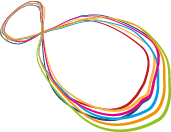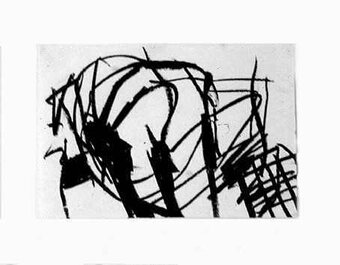Robert Schad
Vita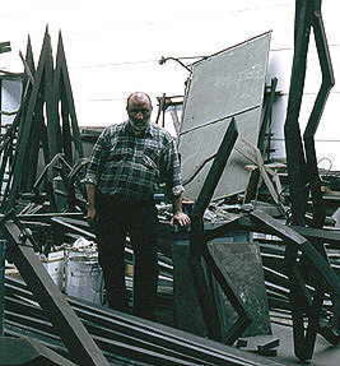
In the studio
Varied models of the fourth dimension: drawings and sculptures
Curves and hatching; thick bars and grids in between. A simple and concise world of forms that unexpectedly unfolds its spatial dimension if you linger in front of the picture for a long time. For it is a picture - untitled, graphite on paper, created in 1985. Soon this decidedly flat sketch of emotions can only be seen as a sculptural form, as a model for a scaffold-like sculpture or as a kind of abstract skeleton.
With this picture, Robert Schad sends the viewer on a journey into an associative space whose dimensions are concretized in a filigree of rods, bars and angles. It is not about limitation and transparency as in the Gothic spatial structure, but about the penetration and marking of invisible spatial axes. The visualization of the invisible was one of the essential tasks of Expressionism and Concrete Art. Paul Klee was of the opinion that under the "shell of the visible world" the creative forces at work become visible. These must be studied and articulated. Robert Schad follows a similar model. He attempts to understand and shape the dimension of space and time as a formal system. However, the time factor is not expressed in comprehensible sequences of movement, but in the succession of spatial layering, which is visualized by the pictorial structure.
The aforementioned graphite drawing already contains features that are expressed in later sculptures. At the same time, they point to the perspectivity of his work: the construction of visual axes with the aim of defining spatial volumes in order to visualize temporality in space. His material: solid square steel. The form: Scaffolding structures.
Robert Schad was born in 1953 in Ravensburg in Upper Swabia. From 1974 to 1980, he studied under Albrecht von Hancke and Wilhelm Loth at the Academy of Fine Arts in Karlsruhe. After graduating, he received a DAAD scholarship for a year to work at the Escola Superior de Belas Artes in Porto/Portugal. This was followed in 1984 by a scholarship from the Baden-Württemberg Art Foundation, in 1987 by a working scholarship from the Kunstfonds e.V. Bonn and in 1988 by a scholarship from the Cité International des Arts in Paris.
Among the long list of public awards, the Grand Prize of the II International Biennial of Sculpture in Obidos, Portugal in 1989/90 stands out. During this period, Robert Schad was a visiting professor at the State Academy of Fine Arts in Stuttgart.
Today, the artist lives with his wife, the musician Erika Stauss, in Larians, a picturesque spot in the Franche Comté. It was there that he founded the "Terrain de Sculpture de Larians" in 2000, which we will talk about in a moment.
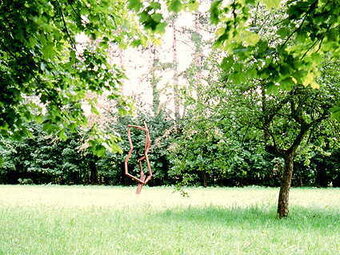
Sculpture in the garden, 1998
Back to the picture on the attic floor of the Heart Center! The sculptural character of the graphite drawing and its spiral torsion refer to a monumental sculpture project that Schad realized in Stuttgart in 1986/87. It involved the so-called "Stuttgarter Weg", a 136 m long connecting tunnel between the parliament building and the House of Representatives of the State Parliament of Baden-Württemberg. At first glance, the expansive network of massive square steel rods appears bizarre. But the tunnel path is suddenly perceived as a space. Just as the scaffold-like ensemble creates space for itself, the person passing through the tunnel may perceive themselves as a "figure in space". They themselves are called upon as actors in a predetermined choreography that they help to create. Schad's tunnel design contributes to the sensitization of perception with regard to the personal sense of space: The succession of movement in space is made conscious by "reading" the tunnel installation.
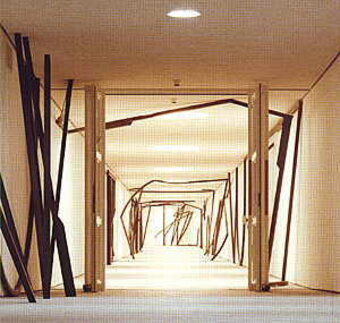
The Stuttgart Way, 1986/87
The entanglement of time and space is crystallized in the aesthetic proximity of movement and sculpture. A body movement is concretized in a specific task, such as walking, bending or reaching. If we break this movement down into individual phases, they appear to us as abstract calculations. The movement analysis of a dance step or a complex choreography can also be thought of as an abstract network. In this context, Schad's sculptures can be understood as concrete models of such a sequence of movements. Better still, his sculptures follow a previously planned and elaborated choreography.
The implied space-time structure in Schad's works experienced a fascinating revelation in 1989: in the Berlin Akademie der Künste, the dancer and choreographer Gerhard Bohner moved in his own figures in the field of tension of sculptural fragments. The spatial installation was created in collaboration with Bohner, who repeatedly created new images through his body movements, which became perceptible as momentary experiences through the medium of sculpture.
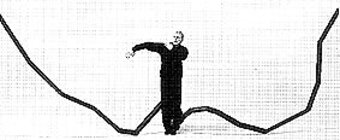
Bohner-Schad project, 1989
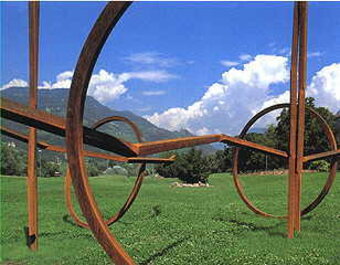
TRI-RULM, 1997
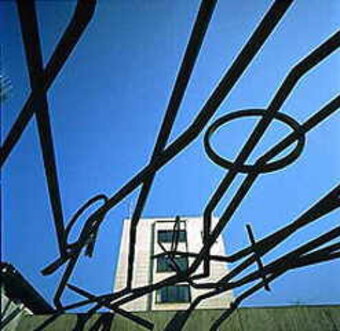
In progress, Freiburg, 1996
Back to the drawing in the heart center! If we understand the composition as a crystallized sequence of movements in the sense of a choreographic sketch, we have approached Schad's "inner figures". I believe that his sculptures are the expression of a harmony of movement whose invisible gesture he actually perceives in the outer space and makes it appear to us with the help of his scaffolding constructions. The interplay between drawing and sculpture certainly points in this direction.
In later years, the Emotions sketch from 1985 gave way to the "built" drawing, which is worked with paint on sheet steel. The comparison with his sculptures opens up new perspectives. It is no longer about surface or space, but about the experience of the aesthetic structure in time. In space, the sculptures can appear two-dimensional - the drawings on the wall spatial. This is due to the glaring black and white contrast and the sharp-edged steel elements. Whether the sculpture is viewed against an urban or landscape backdrop, in most cases it is integrated into an - albeit limited - area of sky. In this way, it combines proximity with distance. It acts as a spatial sculpture and sky drawing in equal measure.
His square steel sculpture TRI-RULM from 1997, erected in the Museion Bolzano in the valley meadows, combines the foreground of the meadow with the bushes and trees in the middle ground as well as with the imposing mountain backdrop and the pathetically cloudy sky to form a unified image. TRI-RULM acts like an artistic generator that creates a kind of aesthetic spatial streamlining in order to lift the "pictorial dimensionality" of the Alpine scenery onto the stage of perception.
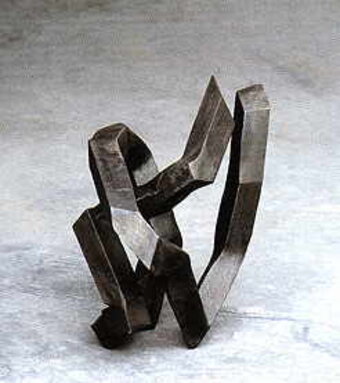
SULOT, 1997
As is well known, the fourth dimension is referred to as space-time and is described with the conceptual model of a "time axis in three-dimensional space". To characterize Schad's sculptures as metaphorical time axes would be too little. They are concrete and varied models of the fourth dimension, insofar as the time axis must not be understood as an abstract straight line or diagonal, but as a differentiated network that marks the different phases of the temporal and their layering in space.
In 2000, Robert Schad founded the "Terrain de Sculpture de Larians" in his home town of Larians. In the park, stelae wind upwards and draw themselves into the sky. Steel circles open up and redefine the park and landscape ambience with every change of position. The structures of nature, be they nearby bumps or distant ridges, are perceived as artistic ornaments through the medium of sculpture. The contour of a fruit tree is reflected in a neighboring steel frame, which appears delicate in this juxtaposition. At this location, the dialog between art and nature is subject to temporality. Just as the light of the day and the colors of the seasons pass over the terrain, the sculptures change and with them the images they create in our perception.
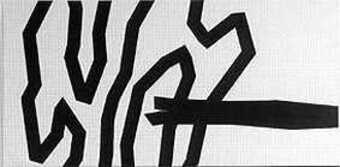
Drawing, paint on sheet steel, 2001

